Anyone living in Arizona knows that the summers here get extremely hot! In this blog, we will explore energy-efficient roofing options.
Using your Air Conditioning in the summertime adds considerably to your electric bill every month. There are ways of saving money by using energy-efficient building materials.
We will talk specifically about choosing energy-efficient roofing materials for the next time you need to re-roof your house or on your new construction home.
There are several types of roofing materials or roof types that are commonly used in Arizona. The most common pitched roofs are tile or shingle. For flat roofs: rolled roofing systems and foam.
So what should someone look for when wanting to choose an energy-efficient roofing material? The easiest way is to look for ENERGY STAR® roofing materials.
The Energy Star logo on the roofing materials packaging indicates that the product is certified to be an energy-efficient roofing material. Energy Star determines roof materials’ energy efficiency by their solar reflectance and emittance.
For example, roofing energy-efficient shingles use granules that reduce the amount of heat that is transferred into the material while shingles that aren’t designed to be energy efficient absorb more heat.
The surface temperature difference between energy-efficient roofing materials with special granules and non-energy efficient materials can be up to 100 degrees Fahrenheit.
Another important thing to take into consideration on choosing your energy-efficient roofing material is color.
Darker colors tend to absorb the sun’s energy and transmit the heat into the building below while lighter colors tend to reflect the sun more efficiently. So it is important to not only choose the color material that you like but also choose lighter tones.
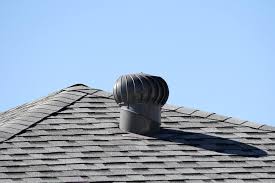
If your roof and attic do not have the proper ventilation then it does not matter what material you use on top of the roof. Improper ventilation will negate the benefits of the energy-efficient roofing material that is used on your roof. In fact, roofing material manufacturers will automatically void material warranties if the roof/attic is not ventilated according to code.
There are many different types of vents that are used depending on the type of roof you have. Here is a roof vent calculator tool if you are wondering how many vents you need.
This photo is used to illustrate what a shingle roof turbine vent looks like. Turbine vents help increase energy efficiency by exhausting hot air from the attic.
We will review different energy-saving options on the common roof types of Arizona. The roof types we will cover are tile, shingle, and flat roofs. Let’s explore the different energy-efficient roofing materials for each type of roof.
Tile roofs are excellent at being energy efficient when it comes to the airflow factor. There is a space between the tiles and the felt that helps promote airflow.
Tile roofs are durable and last a long time. The two main ways to increase the energy efficiency of your tile roof include extra ventilation and installing a reflective foam material on top of your felt. The material that is used commonly in Phoenix is called Radiant Barrier.
This will reflect the heat and prevent it from entering the attic space. While Radiant Barrier is not considered a roofing material, it is very energy efficient! Both of these options will help you save on your monthly electricity bill!
We wrote an article on the best tile underlayment in Arizona, feel free to check it out!
Shingle roofs are very common in Arizona being that they are the most economical roof on the market. Asphalt tends to get really hot in the summer in Arizona.
However, the energy efficiency is lower than tile roofs. The best method of increasing the efficiency of your shingle roof is replacing the old worn-out shingle with the Energy Star rated shingles (which are considered energy-efficient roofing material).
Also, increased ventilation or upgraded ventilation can help as well. Automatic or active vents are a great option and can be programmed to use the fan when the temperature of the attic hits a certain threshold. High-quality vents such as ridge vents also help promote proper ventilation as well.
Flat roofs in Arizona are comprised of many different materials. The most common being asphalt. Asphalt is not an energy-efficient roofing material.
Coating your roof with Acrylic cool roof coatings is a great way to cool down your flat roof. Acrylic elastomeric roof coatings will seal, extend, and renew your flat roof. They will also drop the surface temperature of the roof up to 60 degrees Fahrenheit.
Acrylic Elastomeric roof coatings have strong reflective qualities and are strongly recommended for restoring your old roof, reducing your energy bills, and transforming your roof into being more energy-efficient.
Hands-down polyurethane foam roofs are the best roofs for the hot climate of Arizona and the most energy-efficient roof available.
The system consists of two-part: 1-inch thick polyurethane foam and 1 to 2 coats of acrylic elastomeric coatings (we spoke already about how elastomeric coating is energy-efficient roofing material).
Some of our customers at Mikku and Sons have seen their electricity bill drop by 50% after getting a new Foam Roof. Foam can be installed over pre-existing flat roofs. It is a great system that excels in insulating your home and reflecting the sun. Check out our cool roof systems.
It Depends on the Roof Type. Roofing Costs vary because there are many different roof types in Arizona that will affect how much should pay a roofer to do your roof.
Each type of roof has a different price tag attached to it. In this blog, we will explore the prices of each type of roof available in Arizona to figure out how much you should pay a roofer.
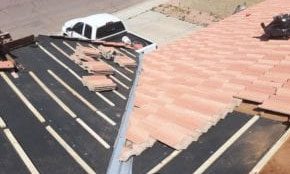
Let’s look at how much you should pay a roofer for a concrete tile roof. A Concrete Tile roof per square (or per 100 square feet) costs $400 to $700 per square for an “R and R” (to remove the tile and replace the existing tile underlayment and reuse the same roof tiles).
'Reusing the same tile is a cost-effective way to replace your roof.
On average, a tile “R and R” for a whole roof costs $7,000 to $15,000 it heavily depending on the size of your roof in Arizona.
Note: this is just an average of how much you should pay a roofer to do your tile roof.
However, some tile brands are brittle and all the tiles need to be replaced which means you will have to pay your roofer more.
In the event that all of the tiles needs to be replaced on your roof the cost per square generally costs:
These prices are supposed to be used as a general guide only on how much you should pay a roofer. Each tile roof varies in size and complexity.
For example, a roof with a larger square area is generally cheaper per square because you get “economies of scale”.
Complexity plays a part in the cost of a new tile roof as well. A roof that is is considered complex has many valleys, different slopes, or angled ridges.
Another price factor is the roofing company you choose. This can make up to a 50% difference in how much you should expect to pay a roofer.
There are many unlicensed “companies” that have rock bottom prices. But should never be an option because they end up usually costing the customer more money when they have to hire a reputable company to fix their roof.
The price range among the roofing companies can vary greatly. For example, our salesman has placed a bid on a job for $15,000.00 and another company had placed a bid for $30,000.00!
The last factor that affects concrete tile roof prices is the quality of the material.
Usually only affects the price by a few hundred to thousands on how much you should pay a roofer (depending on the size of the job). We strongly recommend the best materials to our customers since the ROI is what we focus on.
Using “better” material makes the tile roof last up to 5 to 10 years longer and is worth the extra money!
Let’s look at how much you should pay a roofer for a shingle roof. Shingle roofs are known as the “economical” roof in Arizona.
They are the cheapest roof systems available and last up to 20 to 30 years. They are a great option for “getting the most bang for your buck”.
On an average roof to tear off the existing shingles and install new ones one could expect to pay $7,000 to $15,000.
Note: this is just an average price on how much you should pay a roofer to do your shingle roof.
There are different types of shingles and qualities. The main types in Arizona are Three-tab and Architectural.
Three-tab shingles are a cheaper option than Architectural shingles yet do not last as long (5-7 years less) Usually the price difference between the two is a few hundred for the whole roof.
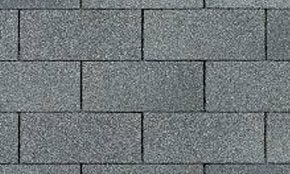
THREE-TAB
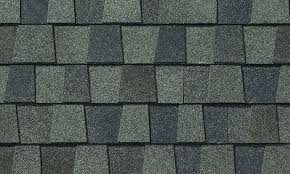
ARCHITECTURAL
Size and complexity play a part in the price as well on how how much you should pay a roofer on a shingle roof.
If the slope of the roof is steeper than 6/12 (6 inches drop over a 12-inch section) then the price will be higher since there is more labor involved. If there are many roof vents that affect the price as well.
Beware of the companies that charge rock bottom prices the shingle market has a low price barrier to enter so there are more unskilled companies that cut corners.
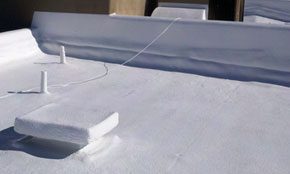
Let’s look at how much you should pay a roofer for a foam roof. Foam roofs are one of the most expensive roofing systems in Arizona but are considered the best option for flat roofs. It has the best insulating properties of any other roof system available on the market.
It is generally $400 to $700 a square. So on average roof size, a new foam roof is around $10,000 to $15,000. Note: this is a general rule of thumb on how much you should pay a roofer to foam your roof.
However, this is not factoring in tearing off the original roof which will vary in cost. Also, a foam roof needs to be re-coated every 5 to 10 years but will last a lifetime if this is done.
So it is important to keep this in mind when thinking about how much you should pay a roofer to install a foam roof.
When it comes time to hire a roofing contractor, it’s not always an easy process. It’s certainly very easy to get on the internet and look at the various companies who claim all kinds of things, but how do you know the work you get will be quality and guaranteed? As a homeowner, a roofing contractor is one of the most important people you will need. Let’s face it, our roof keeps us dry and warm so we need to take care of it! Your property’s continued existence literally depends on your roof’s performance. This is why you need to hire the right roofing contractor.
Hiring a roofer doesn’t have to be a daunting task. Following some simple steps should ensure that you have a positive result. Your roof is one of the most important parts of your property, so take care of it! Remember, if your roof is damaged by weather or other disasters, a good roofing contractor will handle your insurance claims for you!
Don’t just rely on the internet or advertising; ask family and friends and find out about their experiences. If they were satisfied, it’s a pretty sure bet it’s a good company that you can trust to do the job right too.
Once you get a good report from your friends who have used the roofing contractor, be sure to ask questions, such as areas of special expertise and if they are licensed and insured. You should also check with the Better Business Bureau and look online for reviews. Ask them for some recent referrals of jobs they’ve completed and call up their past customers.
Ask them to come to your house so you can discuss the work you need done, as well as what it will entail and how much it will cost. Ask about the time needed to complete the job, as well. Don’t be afraid to ask some difficult questions and if they dodge or won’t answer them, move on to someone else.
After you’ve decided on the company or roofing contractor you would like to hire, draw up a contract! It’s VERY important to have it all in writing and make sure you both sign it and agree to the terms. The contract should include all the details about the job, materials, cost and time. Give the contractor a chance to review the contract and adjust it if necessary. The bottom line here is that you are both on the same page about the task at hand.
A few extra points to consider asking about are clean-up procedures, how compensation is to be handled, liability, and safety concerns. Finally, you should also see to it that a lien waiver is established if there’s a third party involved so if the roofing contractor has failed to pay a vendor, you will not be responsible.
Like most other homeowners, you may not worry much about roofing. However, you need to know that your roof is there to protect you and your home as well.
This article is not going to teach you all that there is to know about getting a roof repaired, but these roofing contractor tips are very important.
If you can afford to, you should always hire a professional roofing contractor, but if you have to work on the roof yourself, make sure that the weather conditions are clear for your own safety.
A wet roof can be slippery. Your roof will also need an ample amount of time to dry. A rain shower the following morning can end up setting you back.
Hose off the shingles, so you can have a clean workplace without a mess of leaves or other debris.
You can also use the hose to find a leak in your roof. One of the best ways to find a source of a roof leak is to use water itself.
It can be tricky to see where a leak is coming from in the middle of a storm, but a garden hose will allow you to test your roof until the leak has been found.
Your best bet, however, is to always hire a professional roofing contractor to inspect and repair your roof.
Do not choose the first roofing contractor you find in the phone book or online. By choosing the first roofing contractor you read about, you may end up spending more money than you need to.
Call numerous roofing contractors and go with the most reliable one at the best price you can find. It's not easy to choose a roofing contractor, but asking for a list of references can be a huge help.
Any roofing contractor which refuses to provide such a list is not one that you want to hire. Don’t just ask for the list, though, be sure to call a few people on it to double-check their experiences.
When inspecting your roof for leaks, it is important that you inspect the whole roof, not just one section. If you find a troublesome area of your roof, you should still check all areas, as there could be more problems elsewhere.
It will be cheaper for you to have all fixes done at the same time, when you hire your roofing contractor, rather than waiting.
If you have a general handyman that does work in and around your home, do not allow him to do anything to your roof.
Fixing a roof requires a high level of experience and know-how. This is why you would be better off hiring a roofing contractor that specializes in this type of work.
The age of your roof is a good indication of whether it needs replacing or not. Most roofs have a lifespan of fifteen to twenty years before replacement is needed. If you have a roof that was put on top of another roof, if 20 years have gone by, you likely must replace it.
Take the roofing contractor’s credentials into consideration during the hiring process. Although credentials do not give you a guarantee that you will get quality work, they do show you how involved the person is with your local community.
It also says a little something about their character as well, which is valuable information.
Any roofing contractor you hire needs to have proper licensing and insurance. If they don’t have this available, then it's best not even to consider hiring this particular roofing contractor.
If your roofing contractor does not have insurance and causes a large amount of damage, then you will be the one to pay.
As was mentioned at the beginning of this article, most homeowners don’t really know too much or concern themselves with roofing.
However, it is an important topic since you will want to protect your family and the items that are contained in your home. Knowing this information will help to keep your family and valuables safe.